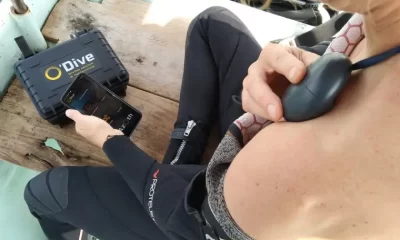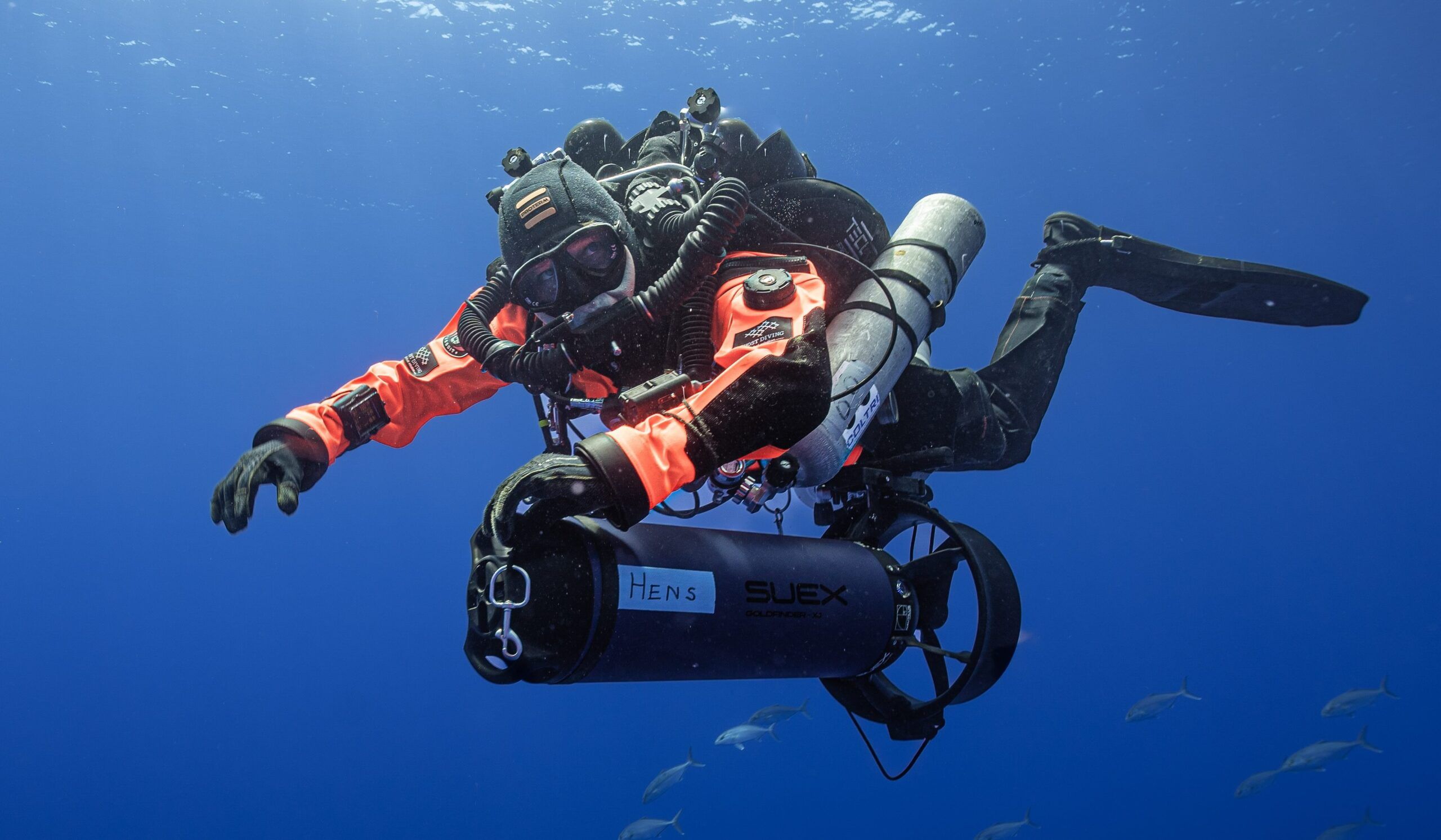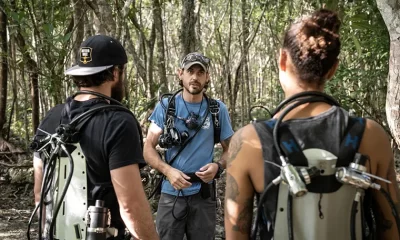Equipment
Decompression Habitats Are Ascendent
Armed with reliable rebreathers, expedition-grade scooters, electric heating, helium mixes, high-powered dive computers, and those all-important P-valves, today’s cave explorers are giving our collective underwater envelope a hard shove (deeper and longer), all the while enduring increasing hours of long, cold, boring decompression. That’s the reason that the use of deco habitats—first pioneered by Dr. Bill Stone in the late 1980s—is on the rise. Here anesthesiologist-cum-cave explorer Andy Pitkin explains everything you need to know about modern deco habitats from their history, construction, and positioning to ensuring adequate, safe breathing gas flow.
By Andy Pitkin
Cold. Hungry. Uncomfortable. Bored. These adjectives can aptly be applied to the vast majority of divers during the decompression portion of advanced technical dives. The commercial diving industry, less concerned about divers’ comfort and more interested in safety and efficiency, has long incorporated decompression in a dry chamber for anything other than shallow diving operations. Unfortunately, with the notable exception of Bill Stone’s 1999 Wakulla 2 project, surface decompression in a pressurized chamber has been impossible for technical divers. The next best thing is a habitat.

Habitats are gas-filled spaces underwater that allow a diver to remain at pressure while getting part or all of their body out of the water. The name comes from experimental living quarters such as the Sealab series where divers would remain underwater for a number of days for (usually) scientific purposes. The habitats used for decompression by technical divers are much more modest, and this article will discuss the theoretical and practical considerations of decompression habitats, some of which are obvious, and some have had to be learned through real-world experience.

Advantages Of Habitats
The benefits of a decompression habitat are so self-evident that they hardly need to be mentioned. The most obvious is warmth, because of the much lower loss of body heat in a gaseous environment compared with immersion in water. Even if only the diver’s head is out of the water there is a significant improvement in both subjective and objective thermal homeostasis. Being out of the water reduces both the risk of oxygen toxicity and the severity of the consequences of a seizure, which is likely to be fatal underwater but could probably be survived in a habitat.
Eating and drinking is much easier, and the ability to talk, listen to music, watch movies and pass the time in relative warmth and comfort makes a long decompression of many hours much easier to tolerate, as well as being considerably safer. A habitat also can be used as a makeshift on-site recompression chamber, which could at least allow a diver’s symptoms to be stabilized while arrangements are made to support the necessarily lengthy in-water decompression phase.

Securing the Habitat
Decompression habitats have occasionally been installed in open water; examples include Martin Robson’s exploration of the Blue Lake in the Russian Caucasus mountains in 2012 [1] and Michael Lombardi’s Ocean Space Habitat, also in 2012 [2]. The overwhelming majority have been used in cave diving, because underwater cave exploration often mandates lengthy decompression and the environment usually guarantees that decompression will occur in a specific location. The wide variety of underwater caves has resulted in many different approaches to construction, from sealing a natural airspace formed by a dome in the ceiling using a tarpaulin (“habitarp”), upturned rubbish bins (“habibin”) to large custom-designed and manufactured enclosures. A volume of gas large enough to be useful has considerable buoyancy, which must be restrained either from above by the cave ceiling or from below using the floor or wall of the cave passage. A 1000 liter (264 gallon) IBC container often used for this purpose has a buoyancy of 1000 kg (2204 lbs), and many habitats are larger.
Unless it is constrained by the cave ceiling, the anchoring system must be very strong and reliable. Natural anchors such as rock projections and large boulders are better for conservation, but they may not be available in the required location, necessitating placement of artificial anchors in the cave wall or floor. These are very similar to anchors used in vertical dry caving, and can be screw anchors, expansion bolts or even glue-in types, typically made of stainless steel (or titanium, if money is no object!).
Air-powered drills are much less expensive than battery-powered underwater drills but can use a large amount of compressed air. When our group (Karst Underwater Research or KUR) placed a habitat 2 km/6562 ft from the entrance of a cave in 2013 (when no suitable battery-powered underwater drill was available), the large volume of bubbles released from the air drill we used to make the holes for the anchors percolated so much silt from the walls and ceiling that the water visibility was reduced to almost zero for about a third of the exit distance. Whatever method of fixing the habitat is chosen, it needs to be very secure, as the consequences of an anchor coming loose could be extremely severe.

The depth of the habitat may be a compromise between what is ideal for decompression and what is dictated by the location. Since the final decompression stop is the longest, the habitat is often targeted as close to 6 m/20 ft deep as possible. Some advanced projects, most notably the Wet Mules’ exploration of the Pearse Resurgence in New Zealand, have used multiple habitats at various depths because of the extreme maximum depth of more than 240 m/787 ft and cold water 6°C/43°F.
To maximize the air space, the habitat container needs to be as level as possible. In other words, the water level can be no lower than the highest point of any of the sides where gas can escape, and this consideration may be more important than installing it at the ideal depth. When a habitat is anchored from below, it is usually easiest to start a little deeper than the intended depth and then adjust to the correct depth before the container is completely filled with gas.
Our group typically uses polyester static caving rope (nylon lengthens about 5-10% on getting wet) with equalized double anchors at the bottom (double figure 8 or bowline on a bight) and ‘super Münter’ adjustable hitches at the top for easy adjustment of length. When the anchor points have been close to the bottom of the habitat, we have had a lot of success with appropriately-rated webbing ratchet straps.

The Use of Containers
Many factors will influence the choice of a container for a habitat, but they can be reduced to two primary ones: location and cost. Inflatable habitats—for example modified commercial lift bags—have the advantage that they can be rolled or folded up to fit through narrow parts of the cave. We have found that a large golf club case works as a streamlined container for an inflatable habitat that can be swum or towed by a DPV.
A rigid habitat, typically an industrial or occasionally purpose-built container, is much more cumbersome to move into a cave, and these are typically installed close to the cave entrance, which obviously has to be large enough for it to fit through. Experience has shown that any modifications to the container (e.g. rings or hooks for hanging equipment) are vastly easier to perform out of the water before the habitat is installed, especially if any kind of adhesive is required. A reliable valve near or at the highest point in the habitat is very helpful for removing gas when the habitat needs to be adjusted or removed but, with a little practice, gas can be siphoned out by two divers and a short length of garden hose.
Unless the cave floor is close to the bottom of the habitat, the occupants will need either a floor or seats to keep them out of the water. The size and positioning of seats is a compromise between comfort and ease of entry into the habitat.
Breathing Gas
The easiest and most inefficient option is for divers to use a conventional open-circuit, second stage regulator, with the cylinder being hung in the water below the habitat. Using a conventional diving rebreather may be difficult because of space limitations, prompting some home-made designs which are usually of the chest-mounted (or ‘laptop’) configuration. They can also be suspended at any convenient place in the airspace, because there is no hydrostatic counterlung loading.
The most efficient and comfortable option is for divers to breathe the habitat atmosphere itself, which immediately presents three new considerations: oxygen addition, carbon dioxide (CO2) removal, and gas monitoring. Let us look at each of these in turn.
Adding Oxygen
The above-mentioned 1000 liter IBC container, large enough for two divers, positioned at 6 msw/20 fsw, and filled with the surface equivalent of 1280 liters of oxygen and 320 liters of nitrogen, would entail an oxygen fraction of 0.8 and a partial pressure of oxygen (PO2) of 1.28 ata. We can conservatively assume that a decompressing diver will have an average oxygen consumption of about 1 liter/minute, and therefore two decompressing divers would consume about 120 liters of oxygen per hour. After one hour, the oxygen fraction within the habitat would have dropped to 0.78 and the PO2 to 1.25 ata, assuming the resulting CO2 does not remain in the airspace. This simple calculation, which is supported by practical experience, shows that elaborate arrangements for maintaining habitat PO2 are unnecessary and can be accomplished by simply purging an oxygen second stage intermittently within the habitat (e.g. every 30 minutes or more).
Removing CO2
There are only two ways of removing CO2 from an enclosed airspace: replacement by adding gas free of CO2, and chemically removing the CO2 from the atmosphere using a CO2 absorbent (scrubber). The first method is often used in hyperbaric chambers—which share many of the practical problems of underwater habitats—because it is safe and simple. Unfortunately for technical divers, it is too inefficient to be practical in most circumstances. Going back to our example above, our two divers will have exhaled about 96 liters of carbon dioxide in the first hour, assuming a typical respiratory quotient of 0.8, resulting in an ambient CO2 concentration of 6.5% (surface equivalent by volume). By this point, both divers would likely be feeling significant adverse effects.
If we assume that the CO2 in the habitat atmosphere should be maintained below the 0.5% surface equivalent value commonly used for rebreather scrubber testing, flushing of the habitat would have to be started after less than 5 minutes. The rate of continuous flushing to keep the CO2 in an enclosed pressurized airspace at a constant level is given by the following equation [3,4]:

where Qgas is the rate of gas ventilation, Pamb is the ambient pressure, VO2 is the total oxygen consumption of the divers, R is the respiratory quotient, F is a mixing factor (1 = ideal mixing) and PCO2 is the desired ambient partial pressure of carbon dioxide.
For our two divers, the habitat would have to be flushed at a rate of 512 liters per minute or 19.5 cu ft per minute (surface equivalent) to maintain the CO2 at a surface equivalent of 0.5%. Note that the amount of gas required is independent of the volume of the habitat. This is logistically unsustainable in most situations: a typical 80 cu ft (11 liter) aluminum cylinder would last less than 3 minutes. This shows how difficult it is to maintain low CO2 levels with flushing of the gas space. Even if the CO2 is allowed to rise to a surface equivalent of 2%, which would cause some breathlessness but might be tolerable, the same cylinder would still only last about 16 minutes.
For the Wakulla project in 1987, Bill Stone calculated a 32 cu.ft./min (906 liters/min) gas flow requirement for an exploration team in that habitat positioned at 60 ft/20 m depth [5]. Two industrial Ingersoll-Rand surface compressors were easily able to meet this demand via a 400 foot long, ¾ inch internal diameter hose with manual shutoff valves and check valves fitted at both ends to prevent inadvertent venting of the habitat atmosphere when the compressors were not running. No direct measurement of habitat CO2 levels were made; the divers were able to purge the gas in the habitat whenever it seemed excessively ‘stuffy’.
The only other way to reduce the CO2 in the atmosphere is to remove it chemically, turning the habitat into a giant shared rebreather. This is relatively a simple engineering task, using a sealed 12V motorcycle radiator fan to blow habitat gas through a scrubber bed, ideally with some form of speed control to allow the flow rate through the absorbent to be controlled by the diver(s). It can be powered from portable battery packs (such as those used for dive lights or undersuit heating) or a cable from the surface. Such a device needs to be transported to the habitat inside an appropriate container or designed into a pressure-proof housing (see picture).

Monitoring Your Gas
When KUR started building habitat scrubbers about 10 years ago, we used a prototype CO2 monitor for a rebreather to help decide how fast to run the scrubber motor. The monitor, which used infrared absorption spectrometry to measure CO2, was power-hungry and would exhaust all of its battery capacity in a few hours if left on continuously, so we would only switch it on intermittently. To pass the time while it was warming up, we would attempt to guess what the reading would be, and after a few iterations we became surprisingly good at estimating the CO2 level subjectively by how ‘stuffy’ the habitat atmosphere felt. Switching on a habitat scrubber fan feels pleasantly like someone opening a window, but the insidious accumulation of CO2 when the scrubber is off is much harder to notice. As an aside, I believe there is some potential for research into whether divers can be trained to recognize increasing levels of inhaled carbon dioxide from scrubber breakthrough. Handheld CO2 meters are available, and we are currently evaluating some of these for use in our habitats. Many are not suitable for the environment or will not give accurate readings in the presence of 100% humidity.
Oxygen measurement is simple, as in any rebreather, and can easily be combined with the scrubber assembly so that the sensors sample the gas being circulated by the fan.
Ensuring Diver Safety
The limited space in most habitats often precludes the use of the divers’ main scuba system, in which case this must be removed when entering the habitat. When leaving for the surface (or a shallower habitat) this must either be redonned or a separate (often simple open-circuit) scuba used. These transitions present some hazards, especially if there is no solid floor beneath the air space with the potential for critical items to be dropped out of reach. A support diver is very valuable to assist a mission diver with entering and exiting the habitat and retrieving any items that are inadvertently released.

As mentioned above, the positive buoyancy of a habitat can easily exceed 1000 kg (10kN) so all anchors, ropes, and connectors such as carabiners and maillon rapides should be appropriately rated for the application. The consequences of a habitat breaking loose in an uncontrolled ascent could be very severe and even fatal.
One concern, especially if the habitat atmosphere has a significantly elevated PO2, is fire safety. With the bottom of the container open to the water, its atmosphere necessarily has 100% humidity, which has been shown experimentally to dramatically inhibit flame spread due to the latent heat of evaporation of water. While practical experience has been reassuring so far, the relative balance of fire-promoting conditions and humidity within a habitat has not yet been scientifically studied, so I would advise great caution with any potential ignition source, especially electrical switches, brushed motors (potential arcing), and dive lights (overheating).
Communications
The Wakulla 1987 project, pioneering in so many ways, introduced the use of habitat to surface communications with two phone lines, one of which was able to be used for long-distance calls, although the pushbutton phone used for the latter became unreliable after a time because of moisture ingress affecting the pushbuttons. Our group, like some others, has adopted single-wire earth-return telephones (also known as Michiephones) for communication with the surface. These are simple, robust, and require only a single wire to be installed to the habitat, although we sometimes use two-conductor military field phone wire with the conductors paralleled for redundancy. You can see them being used in this Alachua “habichat” video.
We have also used the combination of an LTE modem, power-over-ethernet switch, rugged ethernet cable, and a wi-fi access point in a pressure-proof housing to provide internet access within a habitat close to the entrance. While attractive, this option is not suitable for long-term installation and the effort of setting it up for each dive makes our dive teams generally prefer the single wire phone option. Other systems, such as two-wire intercoms for offices or door entry have also been used successfully. All these devices need to be able to function at elevated atmospheric pressure with 100% humidity.
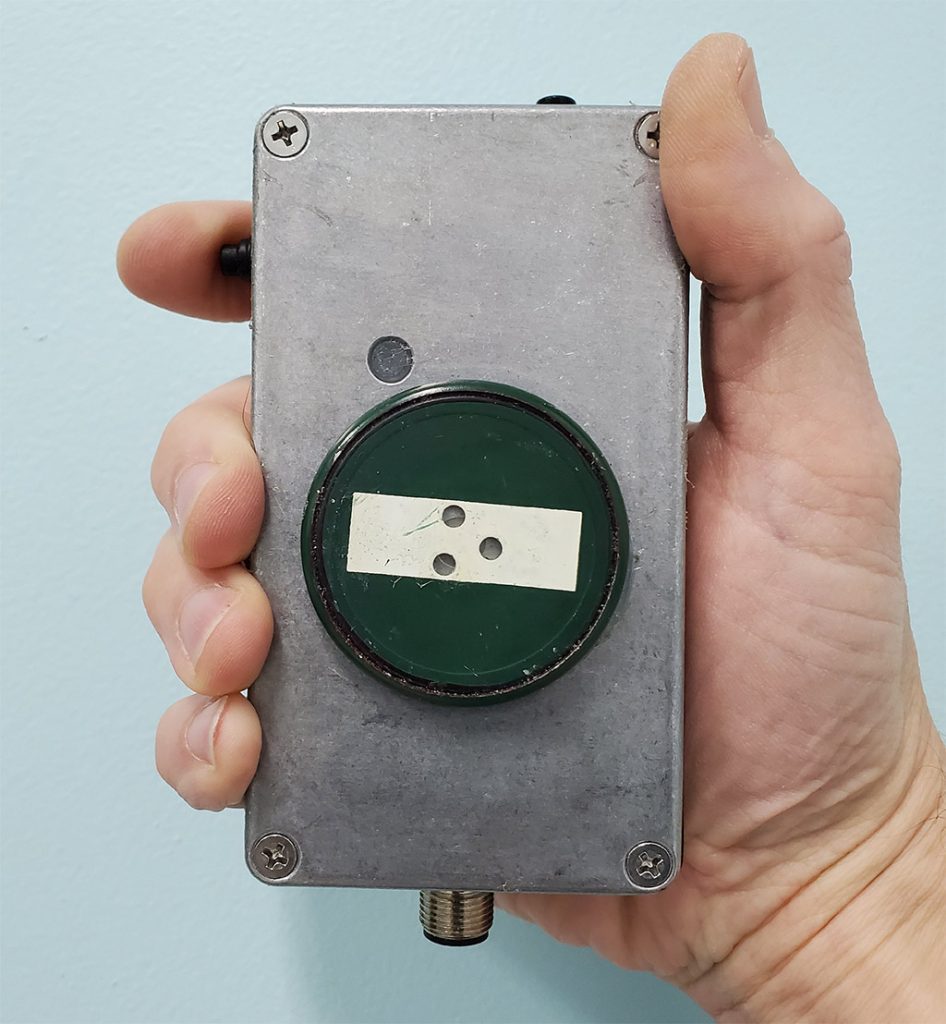
Is There A Deco Habitat in Your Future?
We have already seen one version of the future: the Wakulla 2 project’s surface decompression chamber system with a transfer capsule (“bell”) to transport the divers under pressure from the water into a dry decompression chamber on the surface. Unfortunately very few sites have the geography, and even fewer divers the financial means, to support it.
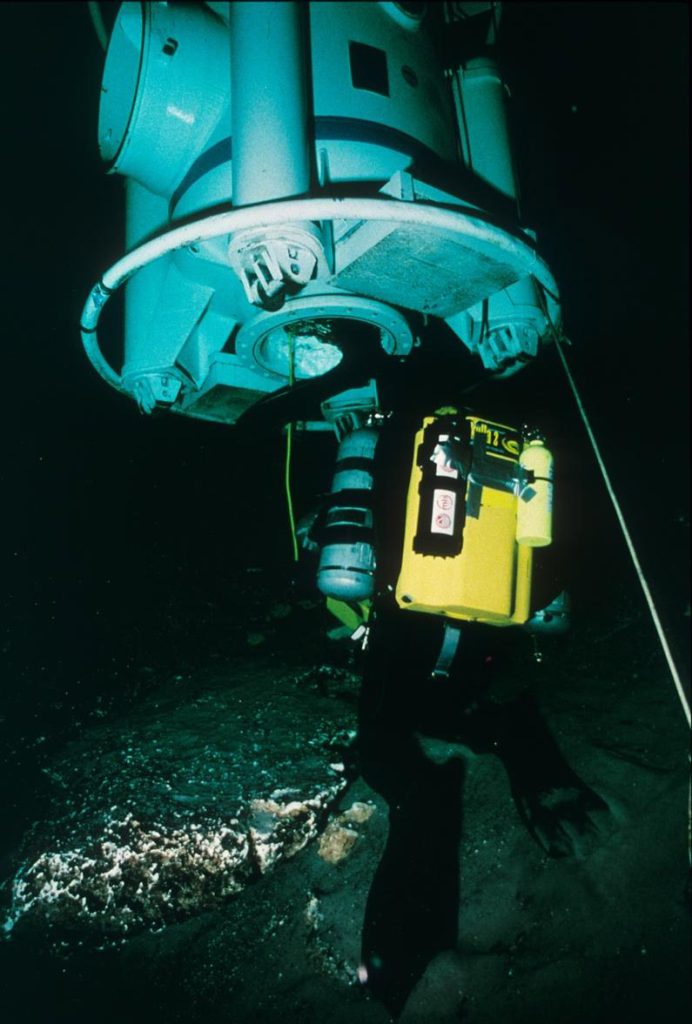
Some explorers have started experimenting with small one-person collapsible habitats which with advances in materials technology can be made more compact and lighter. I foresee more use of purpose-designed enclosures, especially collapsible ones that can be deployed in multiple locations. Underwater rotary hammers are now available which, although expensive, allow rapid placement of anchors in hard limestone. I also anticipate more habitats deployed in open water, like Michael Lombardi’s system-see below.
For deep cave exploration, habitats offer safety, some very welcome mouthpiece-free time, a chance to eat and drink, and even entertainment. More importantly, they allow the diver to warm up and stay warm at a critical phase of the dive, promoting (presumably) better perfusion and faster off-gassing. For these extreme dives, habitats truly change the game.
See Companion article: Portable Habitats—New Technical Diving Capabilities are Well Within Reach by Michael Lombardi
References
[1] Blue Lake: the habitat.
[2] Lombardi M. Portable Habitats: New Technical Diving Capabilities are Well Within Reach. InDEPTH V 4.11
[3] Nuckols ML, Tucher WC, Sarich AJ. Life Support Systems Design: Diving and Hyperbaric Applications. Pearson Custom Publishing, Boston, USA, 1996.
[4] Gerth WA. Chamber Carbon Dioxide and Ventilation. NEDU TR 04-46. Navy Experimental Diving Unit, Panama City, FL, USA, 2004.
[5] Stone WC. The Wakulla Springs Project. U.S. Deep Caving Team. January 1st, 1989. ISBN-10: 0962178500. ISBN-13: 978-0962178504.

Andrew Pitkin learned to dive in 1992 in the cold murky waters of the United Kingdom and started cave and technical diving in 1994. His first exposure to exploration was in 1995 when he was one of a team of divers who were the first to reach the bottom of the Great Blue Hole of Belize at 408 fsw (123 msw). Subsequently he has been involved in numerous cave exploration projects in Belize, Mexico and Florida.
From 1996-2000 he was employed at the Royal Navy’s Institute of Naval Medicine, running a hyperbaric facility, treating decompression illness, participating in research into outcome after decompression illness, submarine escape and testing of new military underwater breathing systems. He is one of a handful of civilians to be trained by the Royal Navy as a diving medical officer.
He moved to Florida in 2007 and is currently on the faculty of the College of Medicine at the University of Florida in Gainesville. With Karst Underwater Research he has participated in numerous underwater cave exploration and filming projects. Like many explorers, he spends much of his spare time developing and building innovative equipment for exploration purposes.























